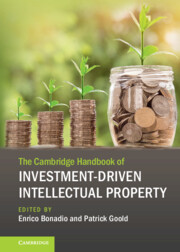Book contents
- The Cambridge Handbook of Investment-Driven Intellectual Property
- The Cambridge Handbook of Investment-Driven Intellectual Property
- Copyright page
- Contents
- Figures and Tables
- Contributors
- Foreword
- Introduction
- I Creativity, Pluralism, and Fictitious Narratives
- Part I Science, Technology and Industry
- II Sui Generis Protection of Non-creative Databases
- III Test Data Exclusivity
- IV Copyright in Works Created by Artificial Intelligence
- V Plant Variety Protection and Investment
- VI Software Protection under Copyright Law
- VII Bilski and the Information Age a Decade Later
- VIII Pharmaceutical Patents and Evergreening
- Part II Culture and Entertainment
- Part III Signs, Images and Designs
V - Plant Variety Protection and Investment
from Part I - Science, Technology and Industry
Published online by Cambridge University Press: 16 March 2023
- The Cambridge Handbook of Investment-Driven Intellectual Property
- The Cambridge Handbook of Investment-Driven Intellectual Property
- Copyright page
- Contents
- Figures and Tables
- Contributors
- Foreword
- Introduction
- I Creativity, Pluralism, and Fictitious Narratives
- Part I Science, Technology and Industry
- II Sui Generis Protection of Non-creative Databases
- III Test Data Exclusivity
- IV Copyright in Works Created by Artificial Intelligence
- V Plant Variety Protection and Investment
- VI Software Protection under Copyright Law
- VII Bilski and the Information Age a Decade Later
- VIII Pharmaceutical Patents and Evergreening
- Part II Culture and Entertainment
- Part III Signs, Images and Designs
Summary
The terms “plant variety” and “investment” may at first appear unrelated. While “plant variety” may bring concepts such as “food,” “nature,” and “farming” to our mind, the word “investment” echoes money and profit. In a market economy, all these concepts are interrelated because money is the medium of exchange that measures and gives value to good and services. While plants and their varieties existing in nature are a result of nature’s “creativity,” any kind of improvement made upon these products of nature is due to intellectual and financial investment. Since the dawn of time, farmers have dedicated considerable time and effort to improving seed and domesticating wild varieties. The importance of plant breeding for agriculture and for other industrial sectors led countries to invest in the seed industry and further develop the sector. For example, the Italian agronomist Nazareno Strampelli helped Italy become self-sufficient in wheat production, which was thereafter exported.1 His work was followed by the “Green Revolution,” for which Normal Borlaug was awarded the Nobel Peace Prize for his valuable contributions in the field.
- Type
- Chapter
- Information
- Publisher: Cambridge University PressPrint publication year: 2023



